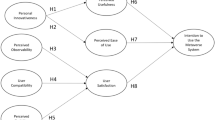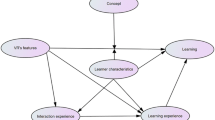Abstract
Technology acceptance is one of the most dynamic research areas in the field of Information Systems (IS). This chapter provides a systematic overview of technology acceptance theories by clarifying the relations among the theories and models. The chapter developed a theoretical model by extending the “Technology Acceptance Model” (TAM) to better explain adoption of visual programming languages by engineering students. The proposed model was tested by using a “structural equation modelling” approach. Results indicated that “perceived enjoyment” was significantly related with perceived usefulness and attitude. Further, the results indicated that “self-efficacy” was significantly related with perceived ease of use. The proposed model better explained the adoption of Scratch by predicting 75% of the variance in continuous use intention.
Access this chapter
Tax calculation will be finalised at checkout
Purchases are for personal use only
Similar content being viewed by others
References
Sloan, R.H., Troy, P.: CS 0.5: a better approach to introductory computer science for majors. In: SIGCSE’08—Proceedings of 39th ACM technical symposium on computer science education, pp. 271–275 (2008). https://doi.org/10.1145/1352135.1352230
Rizvi, M., Humphries, T.: A scratch-based CS0 course for at-risk computer science majors. In: Proceedings—frontiers in education conference FIE (2012). https://doi.org/10.1109/fie.2012.6462491
De, K.: Scratch: applications in computer science 1. In: Proceedings—frontiers in education conference FIE, pp. 7–11 (2008)
Kölling, M.: The Greenfoot programming environment. ACM Trans. Comput. Educ. 10(4), 1–21 (2010). https://doi.org/10.1145/1868358.1868361
Cooper, S.: The design of alice. ACM Trans. Comput. Educ. 10(4), 1–16 (2010). https://doi.org/10.1145/1868358.1868362
Maloney, J., Resnick, M., Rusk, N., Silverman, B., Eastmond, E.: The scratch programming language and environment. ACM Trans. Comput. Educ. 10(4), 1–15 (2010). https://doi.org/10.1145/1868358.1868363
Fernández Leiva, A.J., Civila Salas, A.C.: Practices of advanced programming: Tradition versus innovation. Comput. Appl. Eng. Educ. 21(2), 237–244 (2013). https://doi.org/10.1002/cae.20465
Resnick, B.Y., Brennan, K., Kafai, Y.: Scratch: programming for all. Comm. ACM 52(11), 60–67 (2009). https://doi.org/10.1145/1592761.1592779
Wolz, U., Maloney, J., Pulimood, S.M.: ‘Scratch’ your way to introductory CS. In: SIGCSE’08—Proceedings of 39th ACM technical symposium computer science education, pp. 298–299 (2008). https://doi.org/10.1145/1352135.1352239
Venkatesh, V., Morris, M.G., Davis, G.B., Davis, F.D.: User acceptance of information technology: toward a unified view. MIS Q. 1, 425–478 (2003)
Al-emran, M., Mezhuyev, V., Kamaludin, A.: Technology acceptance model in m-learning context: a systematic review. Comput. Educ. 125, 389–412 (2018). https://doi.org/10.1016/j.compedu.2018.06.008
Al-Emran, M., Arpaci, I., Salloum, S.A.: An empirical examination of continuous intention to use m-learning: an integrated model. Educ. Inf. Technol. (2020). https://doi.org/10.1007/s10639-019-10094-2
Al-Emran, M., Al-Maroof, R., Al-Sharafi, M.A., Arpaci, I.: What impacts learning with wearables? An integrated theoretical model. Interact. Learn. Environ. 0(0), 1–21 (2020). https://doi.org/10.1080/10494820.2020.1753216
Arpaci, I.: E-government and technological innovation in Turkey: Case studies on governmental organizations. Transform. Gov. People Process Policy 4(1), 37–53 (2010). https://doi.org/10.1108/17506161011028795
Arpaci, I., Yardimci Cetin, Y., Turetken, O.: A cross-cultural analysis of smartphone adoption by Canadian and Turkish organizations. J. Glob. Inf. Technol. Manage. 18(3), 214–238 (2015). https://doi.org/10.1080/1097198x.2015.1080052
Arpaci, I., Yardimci Cetin, Y., Turetken, O.: Impact of perceived security on organizational adoption of smartphones. Cyberpsychol. Behav. Soc. Networking 18(10), 602–608 (2015). https://doi.org/10.1089/cyber.2015.0243
Arpaci, I.: A comparative study of the effects of cultural differences on the adoption of mobile learning. Br. J. Educ. Technol. 46(4), 699–712 (2015). https://doi.org/10.1111/bjet.12160
Arpaci, I., Baloğlu, M.: The impact of cultural collectivism on knowledge sharing among information technology majoring undergraduates. Comput. Hum. Behav. 1(56), 65–71 (2016). https://doi.org/10.1016/j.chb.2015.11.031
Arpaci, I.: Understanding and predicting students’ intention to use mobile cloud storage services. Comput. Hum. Behav. 1(58), 150–157 (2016). https://doi.org/10.1016/j.chb.2015.12.067
Arpaci, İ.: An investigation of the relationship between cultural orientations and collaborative learning and its implications on higher education. Sakarya Univ. J. Educ. 6(2), 209–221 (2016). https://doi.org/10.19126/suje.22570
Arpaci, I.: Design and development of educational multimedia: the software development process for mobile learning. In: Blended Learning: Concepts, Methodologies, Tools, and Applications. IGI Global, Information Science Reference, Hershey, PA (2016). https://doi.org/10.4018/978-1-5225-0783-3.ch018
Arpaci, I.: The role of self-efficacy in predicting use of distance education tools and learning management systems. Turk. Online J. Dist. Educ. 18(1), 52–62 (2017)
Arpaci, I.: A qualitative study on the adoption of bring your own device (BYOD) practice. Int. J. E-Adoption 7(2), 1–14 (2015). https://doi.org/10.4018/ijea.2015070101
Arpaci, I.: Antecedents and consequences of cloud computing adoption in education to achieve knowledge management. Comput. Human Behav. 70, 382–390 (2017). https://doi.org/10.1016/j.chb.2017.01.024
Arpaci, I.: Innovation policy and technological innovation in the public organizations. METU Stud. Develop. 38(2), 111–123
Arpaci, I.: A hybrid modeling approach for predicting the educational use of mobile cloud computing services in higher education. Comput. Human Behav. 90, 181–187 (2019). https://doi.org/10.1016/j.chb.2018.09.005
Arpaci, I., Basol, G.: The impact of preservice teachers’ cognitive and technological perceptions on their continuous intention to use flipped classroom. Educ. Inf. Technol. (2020). https://doi.org/10.1007/s10639-020-10104-8
Arpaci, I.: Organizational adoption of mobile communication technologies. Ph.D. dissertation, Middle East Technical Univ., Ankara (2013). Accessed on 31 May 2020. [Online]. Available: http://etd.lib.metu.edu.tr/upload/12616630/index.pdf
Fishbein, M., Ajzen, I.: Belief, Attitude, Intention and Behaviour: An Introduction to Theory and Research. Reading, Addison-Wesley (1975)
Ajzen, I.: Attitude structure and behavior. Attitude Struct. Funct. 1, 241–274 (1989)
Davis, F.D.: Perceived usefulness, perceived ease of use, and user acceptance of information technology. MIS Q. Manag. Inf. Syst. 13(3), 319–339 (1989). https://doi.org/10.2307/249008
Davis, F.D., Bagozzi, R.P., Warshaw, P.R.: User acceptance of computer technology: A comparison of two theoretical models. Manage. Sci. 35(8), 982–1003 (1989). https://doi.org/10.1287/mnsc.35.8.982
Venkatesh, V., Davis, F.D.: A model of the antecedents of perceived ease of use: development and test. Decis. Sci. 27(3), 451–481 (1996). https://doi.org/10.1111/j.1540-5915.1996.tb01822.x
Venkatesh, V., Davis, F.D.: Theoretical extension of the technology acceptance model: four longitudinal field studies. Manage. Sci. 46(2), 186–204 (2000). https://doi.org/10.1287/mnsc.46.2.186.11926
Venkatesh, V., Bala, H.: Technology acceptance model 3 and a research agenda on interventions. J. Decis. Sci. Inst. 39(2), 273–315 (2008). https://doi.org/10.1111/j.1540-5915.2008.00192.x
DeLone, W.H., McLean, E.R.: The DeLone and McLean model of information systems success: a ten-year update. J. Manag. Inf. Syst. 19(4), 9–30 (2003). https://doi.org/10.1080/07421222.2003.11045748
DeLone, W.H., McLean, E.R.: Measuring e-commerce success: Applying the DeLone and McLean information systems success model. Int. J. Electron. Commer. 9(1), 31–47 (2004). https://doi.org/10.1080/10864415.2004.11044317
Goodhue, D.L., Thompson, R.L.: Task-technology fit and individual performance. MIS Q. Manag. Inf. Syst. 19(2), 213–233 (1995). https://doi.org/10.2307/249689
Zhou, T., Lu, Y., Wang, B.: Integrating TTF and UTAUT to explain mobile banking user adoption. Comput. Human Behav. 26(4), 760–767 (2010). https://doi.org/10.1016/j.chb.2010.01.013
Rogers, E.M.: Diffusion of Innovations. The Free Press, New York, NY (1983)
Rogers, E.M.: Diffusion of Innovations. The Free Press, New York, NY (1995)
Fishbein, M., Ajzen, I.: Attitudes towards objects as predictors of single and multiple behavioral criteria. Psychol. Rev. 81(1), 59–74 (1974). https://doi.org/10.1037/h0035872
Ajzen, I.: The theory of planned behavior. Organ. Behav. Hum. Decis. Process. 50(2), 179–211 (1991). https://doi.org/10.1016/0749-5978(91)90020-t
Moore, G.C., Benbasat, I.: Development of an instrument to measure the perceptions of adopting an IT innovation.pdf. Inf. Syst. Res. 2(3), 192–222 (1991)
Compeau, Deborah R., Higgins, Christopher A.: Computer self-efficacy: development of a measure and initial test. MIS Q. 19(2), 189–211 (1995)
Venkatesh, V.: Determinants of perceived ease of use: Integrating control, intrinsic motivation, and emotion into the technology acceptance model. Inf. Syst. Res. 11(4), 342–365 (2000). https://doi.org/10.1287/isre.11.4.342.11872
Webster, J., Martocchio, J.J.: Microcomputer playfulness: Development of a measure with workplace implications. MIS Q. Manag. Inf. Syst. 16(2), 201–224 (1992). https://doi.org/10.2307/249576
Arpaci, I., Durdu, P.O., Mutlu, A.: The role of self-efficacy and perceived enjoyment in predicting computer engineering students’ continuous use intention of scratch. Int. J. E-Adoption 11(2), 1–12 (2019). https://doi.org/10.4018/ijea.2019070101
Arpaci, I.: E-Turkey: Turkey’s way to the information society. In: Piaggesi, D., Sund, K., Castelnovo, W. (eds.) Global Strategy and Practice of E-governance: Examples from Around the World, pp. 272–285. IGI Global, Information Science Reference, Hershey, PA (2011). https://doi.org/10.4018/978-1-60960-489-9
Davis, F.D., Bagozzi, R.P., Warshaw, P.R.: Extrinsic and intrinsic motivation to use computers in the workplace. J. Appl. Soc. Psychol. 22(14), 1111–1132 (1992). https://doi.org/10.1111/j.1559-1816.1992.tb00945.x
Bandura, A.: Self-Efficacy: The Exercise of Control. Macmillan, New York (1997)
Yang, H.J., Lay, Y.L.: Implementation and evaluation of computer-aided Mandarin phonemes training system for hearing-impaired students. Br. J. Educ. Technol. 36(3), 537–551 (2005). https://doi.org/10.1111/j.1467-8535.2005.00498.x
Creswell, J.W.: Quantitative and Qualitative Approaches, 4th edn. Pearson, Boston, MA (2012)
Author information
Authors and Affiliations
Corresponding author
Editor information
Editors and Affiliations
Rights and permissions
Copyright information
© 2021 Springer Nature Switzerland AG
About this chapter
Cite this chapter
Arpaci, I. (2021). Predicting Adoption of Visual Programming Languages: An Extension of the Technology Acceptance Model. In: Al-Emran, M., Shaalan, K. (eds) Recent Advances in Technology Acceptance Models and Theories. Studies in Systems, Decision and Control, vol 335. Springer, Cham. https://doi.org/10.1007/978-3-030-64987-6_4
Download citation
DOI: https://doi.org/10.1007/978-3-030-64987-6_4
Published:
Publisher Name: Springer, Cham
Print ISBN: 978-3-030-64986-9
Online ISBN: 978-3-030-64987-6
eBook Packages: Intelligent Technologies and RoboticsIntelligent Technologies and Robotics (R0)




